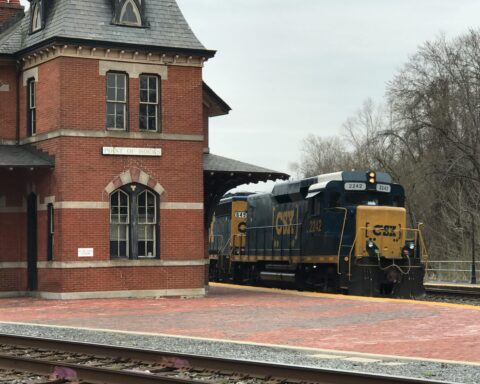Eight days after a fire caused substantial damage to a portion of the Interstate 10 freeway on the south side of Los Angeles, the California Department of Transportation reopened the highway. The project is one example of how federal quick-release funds can help accelerate emergency repairs on major highways.
The massive fire – believed to be the result of arson – broke out Nov. 11 as a result of material being stored below the freeway. The state’s airspace lease program allows private companies to rent space below freeways for storage.
The fire damaged 100 columns along a 450-foot-span of the freeway, California Gov. Gavin Newsom said. The total cost for the repairs to reopen the freeway is still being estimated but is likely to be around $3 million. The state will be 100% reimbursed by the federal government through the emergency relief fund for all costs up until the reopening of 10 lanes of the I-10, which occurred the evening of Nov. 19.
Initial estimates of the scene indicated the freeway could be closed for six months for repairs and possible replacement. However, that estimate was reduced to three to five weeks as Caltrans realized the damage wasn’t quite as significant and didn’t require an emergency rebuild.
“We were running in parallel an operation to literally secure a prefab freeway that would be constructed offsite to bring on-site,” Newsom said at a Nov. 19 news conference.
Chemical testing of the structures later revealed Caltrans wouldn’t have to retrofit the portion of the freeway and could repair the existing structures, Newsom said.
“Then everything went our way,” he said.
Aiding the repairs
In the event a federal highway has extensive damage from either a natural disaster or an external cause, the Federal Highway Administration (FHWA) can issue emergency relief (ER) or quick-release funds to cover the cost of emergency repairs. To be eligible, the highway must have been severely damaged over a wide area, and repairs must be complete within 180 days after the incident.
The FHWA announced Nov. 15 that Caltrans would receive $3 million in quick-release funds for the emergency repairs to the I-10 Freeway.
Each year, Congress authorizes $100 million for the ER program. Agencies that apply for the funds could also have to share in the cost; however, the federal share could be 80% or 90% depending on the type of highway. For emergency repair work that would restore key travel, as was the case of the I-10 for the week of Thanksgiving, the costs could be reimbursed at 100%.
“That law is not just responsible for funding and the reopening of I-10. The Bipartisan Infrastructure Law is also a significant investment in public transit, which many commuters first experienced this last week,” California Sen. Alex Padilla said Nov. 19.
California has previously received emergency relief funds for other incidents. From 2012 to May 2023, the state has received over $219 million in emergency relief funds, mostly the result of wildfires, including almost $78.7 million for damage to highways in 2020.
ER funds have been used for other major highway incidents, including the I-95 bridge collapse in Philadelphia in June. That bridge fell when a gasoline tanker truck crashed and exploded under the highway. The state received $3 million in ER funds to repair the bridge.
In 2017, a bridge collapsed on the I-85 in Atlanta, also due to a fire from materials being stored under the highway. The Georgia Department of Transportation received $10 million from the FHWA in ER funds to repair and reopen the bridge just 43 days later.
Additionally, GDoT relied on incentives to encourage contractors to work as quickly as possible, offering $200,000 per day for earlier completion.
Caltrans also utilized incentives to speed up highway repairs after the 1994 Northridge earthquake, offering $150,000 a day for quicker completion.
Collaboration is key
Government agencies were also able to move quickly on the I-10 repairs because of the Caltrans pre-approval process for contractors.
Caltrans allows companies to receive pre-approval not only before bidding on construction projects, but it also has a list of contractors pre-approved for emergency work.
Two contractors, Griffith Co. and Security Paving Co., received pre-approval and were able to move quickly in removing debris and begin repairs, Newsom said. Griffith was able to shave off two to three days from the timeline by expediting debris removal, he said.
“We were able to secure the kind of equipment we needed to get on-site to make sure we were able to complement that with … labor hours – 10,000 labor hours all told – to get us to this point ahead of schedule – eight days to get this thing open and operational,” he said.
Permanent fixes to the portion of the freeway will occur over the next few weeks but will not require significant closures that affect commuters, Newsom said. This work will include additional temporary shoring of structures to complete concrete work.
In the I-85 bridge collapse, GDoT relied on its public-private partnerships and innovation to accelerate the extensive repairs, according to Marc Mastronardi, the deputy chief engineer for GDOT. In the FHWA’s Public Roads magazine, Mastronardi detailed GDOT’s response to the collapse.
He said GDoT was able to use C.W. Matthews Contracting Co. Inc., which was working on a nearby site, to aid in the I-85 repairs. CWM also used Griffin Co. to demolish the damaged structures hours after the fire.
Crews also worked round-the-clock to rebuild the 13 bridge columns and 61 beams by alternating 12- to 14-hour shifts, Mastronardi wrote.
“While the weather was on their side – only half of one shift was lost to inclement weather – the project’s success primarily came from the partnership and commitment from all involved, as well as GDOT’s willingness to use innovative contracting methods,” he wrote.
All news and information on this site is provided by the team at Strategic Partnerships, Inc. Check out this short 1-minute video that provides a quick overview of how we work with clients.













